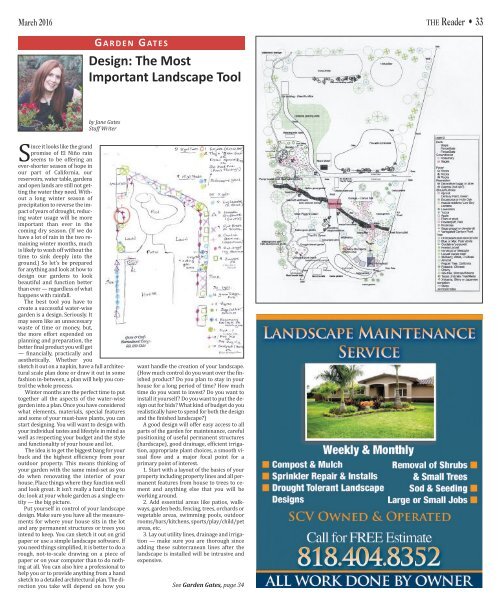You also want an ePaper? Increase the reach of your titles
YUMPU automatically turns print PDFs into web optimized ePapers that Google loves.
<strong>March</strong> <strong>2016</strong> THE <strong>Reader</strong> • 33<br />
g a r D e n g at e S<br />
Design: the most<br />
important landscape tool<br />
by Jane Gates<br />
Staff Writer<br />
Since it looks like the grand<br />
promise of El Niño rain<br />
seems to be offering an<br />
ever-shorter season of hope in<br />
our part of California, our<br />
reservoirs, water table, gardens<br />
and open lands are still not getting<br />
the water they need. Without<br />
a long winter season of<br />
precipitation to reverse the impact<br />
of years of drought, reducing<br />
water usage will be more<br />
important than ever in the<br />
coming dry season. (If we do<br />
have a lot of rain in the two remaining<br />
winter months, much<br />
is likely to wash off without the<br />
time to sink deeply into the<br />
ground.) So let’s be prepared<br />
for anything and look at how to<br />
design our gardens to look<br />
beautiful and function better<br />
than ever — regardless of what<br />
happens with rainfall.<br />
The best tool you have to<br />
create a successful water-wise<br />
garden is a design. Seriously. It<br />
may seem like an unnecessary<br />
waste of time or money, but,<br />
the more effort expended on<br />
planning and preparation, the<br />
better final product you will get<br />
— financially, practically and<br />
aesthetically. Whether you<br />
sketch it out on a napkin, have a full architectural<br />
scale plan done or draw it out in some<br />
fashion in-between, a plan will help you control<br />
the whole process.<br />
Winter months are the perfect time to put<br />
together all the aspects of the water-wise<br />
garden into a plan. Once you have considered<br />
what elements, materials, special features<br />
and some of your must-have plants, you can<br />
start designing. You will want to design with<br />
your individual tastes and lifestyle in mind as<br />
well as respecting your budget and the style<br />
and functionality of your house and lot.<br />
The idea is to get the biggest bang for your<br />
buck and the highest efficiency from your<br />
outdoor property. This means thinking of<br />
your garden with the same mind-set as you<br />
do when renovating the interior of your<br />
house. Place things where they function well<br />
and look great. It isn’t really a hard thing to<br />
do; look at your whole garden as a single entity<br />
— the big picture.<br />
Put yourself in control of your landscape<br />
design. Make sure you have all the measurements<br />
for where your house sits in the lot<br />
and any permanent structures or trees you<br />
intend to keep. You can sketch it out on grid<br />
paper or use a simple landscape software. If<br />
you need things simplified, it is better to do a<br />
rough, not-to-scale drawing on a piece of<br />
paper or on your computer than to do nothing<br />
at all. You can also hire a professional to<br />
help you or to provide anything from a hand<br />
sketch to a detailed architectural plan. The direction<br />
you take will depend on how you<br />
want handle the creation of your landscape.<br />
(How much control do you want over the finished<br />
product? Do you plan to stay in your<br />
house for a long period of time? How much<br />
time do you want to invest? Do you want to<br />
install it yourself? Do you want to put the design<br />
out for bids? What kind of budget do you<br />
realistically have to spend for both the design<br />
and the finished landscape?)<br />
A good design will offer easy access to all<br />
parts of the garden for maintenance, careful<br />
positioning of useful permanent structures<br />
(hardscape), good drainage, efficient irrigation,<br />
appropriate plant choices, a smooth visual<br />
flow and a major focal point for a<br />
primary point of interest.<br />
1. Start with a layout of the basics of your<br />
property including property lines and all permanent<br />
features from house to trees to cement<br />
and anything else that you will be<br />
working around.<br />
2. Add essential areas like patios, walkways,<br />
garden beds, fencing, trees, orchards or<br />
vegetable areas, swimming pools, outdoor<br />
rooms/bars/kitchens, sports/play/child/pet<br />
areas, etc.<br />
3. Lay out utility lines, drainage and irrigation<br />
— make sure you are thorough since<br />
adding these subterranean lines after the<br />
landscape is installed will be intrusive and<br />
expensive.<br />
See Garden Gates, page 34

















